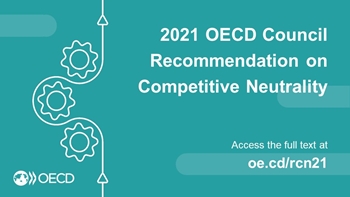Competition
Competitive neutrality in competition policy
|
It is a fundamental principle of competition law and policy that firms should compete on the merits and should not benefit from undue advantages for example due to their ownership or nationality. Government actions can sometimes prevent, restrict or distort competition within a market. They can set procurement/tax rules or regulatory regimes putting private companies at a disadvantage compared to state-controlled or supported firms, or yet, they can assign market regulatory functions to firms that currently or potentially compete on the same markets. Ensuring a level playing field is, therefore, key to enabling competition to work properly and deliver benefits to consumers and the wider economy. Throughout the years, the OECD Competition Committee has taken different initiatives to analyse the topic from different angles. |
31/05/21 - OECD Council approves recommendation on competitive neutrality |
|
Chronology of OECD Competition work
In 2004, a first in-depth discussion was held on the role of the state in the market and the potential distortion of competition arising from the advantages granted to state entities. Advantages could take the form of tax benefits, lower-cost financing opportunities, direct subsidies, lax procurement rules and exemption from competition law. In 2009, a second roundtable discussion looked more closely at the challenges of enforcing competition rules against state-owned enterprises. It acknowledged, however, that in addition to competition law, other legislative and administrative frameworks (e.g. bankruptcy and tax rules) should contribute to achieving competitive neutrality between publicly- and privately-owned competitors. In 2012, the Competition Committee engaged in a joint project with the OECD’s Working Party on State Ownership and Privatisation Practices to map national practices and policies that address the issue of public-private competition. Building around eight priority areas to be addressed by national authorities, it compiled a compendium of OECD Recommendations, Guidelines and best practices that may have implications for competitive neutrality. The eight priority areas include the operational form of government business, cost identification, rate of return requirements, public service obligations, tax neutrality, debt neutrality, regulatory neutrality, and public procurement practices. In 2015 the OECD gathered competition experts and representatives of other policy communities (investment, trade, tax, regulated industries and regulatory governance) to discuss challenges arising from state interventions in the market and what competition authorities could do to address the distortions that such interventions can create. A separate discussion brought to light a variety of best practices and useful laws and instruments available around the world to address competition distortions. The exchange produced two documents:
In addition to the above-mentioned discussions and material, the OECD also conducted in-country projects to assess competitive neutrality. In 2018, the project Fostering Competition in ASEAN started and included a component reviewing competitive neutrality in the sector of small-package delivery services in each of the ASEAN member countries. The project is currently ongoing but outputs can already be accessed on this page Towards a Level Playing Field between SOEs and Private Entities in ASEAN. In 2019, the OECD Working Party No.2 of the Competition Committee held a session with presentations by delegations on the tool that they use to address competitive neutrality issues in their markets. The presentations can be found below. In 2021, building upon the significant experience acquired throughout the discussions over the years and benefiting from consultations with different OECD bodies the OECD Council adopted the 2021 Recommendation on Competitive Neutrality. The Recommendation establishes a set of principles ensuring that governments’ actions are competitively neutral and that all enterprises face a level playing field, irrespective of factors such as the enterprises’ ownership, location or legal form. It recommends adopting and maintaining neutral market rules so that adhering governments ensure that the legal framework is neutral and that competition is not unduly prevented, restricted or distorted. It also recommends avoiding selective advantages and measures that may unduly enhance an enterprise’s market performance and distort competition. Access the full text of the 2021 Recommendation on Competitive Neutrality
In December 2021, the OECD Global Forum on Competition will hold a discussion on the promotion of competitive neutrality by competition authorities. |
Videos
Competitive neutrality explained in 6 minutes
2022 OECD Competition Open Day - Replay of Panel 2. Competitive Neutrality and the Role of the State
Documents and links
Subsidies, Competition and Trade, 2022 Overview of OECD work on competitive neutrality The promotion of competitive neutrality by competition authorities, 2021 Towards a Level Playing Field between SOEs and Private Entities in ASEAN The size and sectoral distribution of state-owned enterprises, September 2017 For globalisation to work for all, you have to level the playing field first, 30 May 2017 Business and Finance Outlook, 2017 State-owned enterprises as global competitors: A challenge or an opportunity? 2016 Note on competition and competitive neutrality for other policy areas, 2015 Inventory of competitive neutrality distortions and measures, 2015 Competitive Neutrality: Maintaining a level playing field between public and private business, 2012 National Practices concerning competitive neutrality, 2012 Competitive Neutrality and State-Owned Enterprises, Corporate Governance Working Papers, No. 1, 2011 State-Owned Enterprises and the Principle of Competitive Neutrality, 2009 |
|
2019 PRESENTATIONS ON TOOLS FOR ADDRESSING COMPETITIVE NEUTRALITY
|
|||||||||||||||||
Related Documents
